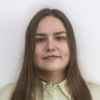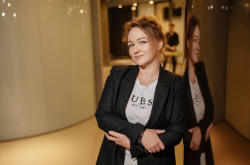How did you come up with the idea for your startup? And why did you opt for medicine – not the easiest field?
The idea came from my personal experience. My family often visits the dentist. And we often have to face many problems: from finding the right specialist to incorrect diagnosis and repeated treatment. At a certain point, I realized in Russia there wasn’t a simple, accessible system for monitoring dental health – so I decided to create one.
What was your starting point? Did you have any expertise?
Before launching the startup, I spent two years at a cell lab developing new dental products. That’s why our first step was making dental kits for self-diagnostics of cavities. However, they turned out hard to use: almost all users failed to make correct casts of their teeth.
Finally, we found a solution in the field of AI -- a dental ecosystem that will support people on every step of their dental care. We created a neural network that can analyze the state of users’ teeth based on their photos.
How does it work?
Our neural network is implemented in the web application SmileAI. This algorithm was developed in collaboration with professional dentists in Russia and has been tested by specialists to confirm the quality of the data provided by the neural network. The user visits the website and completes a short questionnaire, indicating their age, gender, and information about their current dental health – such as whether their teeth react to cold, acidic, or sweet stimuli. Next, the user has to upload photos of the oral cavity from three angles: a frontal view, and the upper and lower parts of the jaw. The website has a guide on how to take the photos correctly. Additionally, if the images are not in the correct format or are of poor quality, the program will request new ones. We are also currently working on a video that will show in detail how to photograph the oral cavity, further simplifying the process of using the neural network.
Within five minutes, based on the analysis, the user receives indicators of the overall condition of their oral cavity, hygiene, and the health and integrity of their teeth and gums. Based on this data, recommendations for dental care are provided, along with suitable hygiene products.
If the diagnostics reveals the presence of cavities, users can schedule an appointment with a dentist on the website. The list of clinics was compiled based on patient reviews, information about the experience, education, and qualifications of doctors, as well as surveys conducted manually by hospital staff, which included calling both doctors and patients.
How did you train the network? What is its current error rate?
We used over 60,000 photos from users to train the network. We collected data from open sources, such as dental clinic websites, from acquaintances, and with the help of specialists, who sent us photos of their patients taken on their phones. However, it's important to note that all photos were anonymized, and before the photos were taken, users gave consent for their personal data to be processed. Additionally, all the data obtained was encrypted.
First, the images were analyzed by experienced dentists: they identified any issues with teeth or gums, evaluated the oral cavity’s hygiene, health, and integrity. Then, we compared this data and selected only those images that were evaluated in the same way by all the specialists for marking. This helped us reach the highest objectivity and accuracy. These final images were used to train the model.
Currently, more than a thousand people have undergone diagnostics through the service. The accuracy rate is now 80%, but we continue to train the neural network and aim for 95%. We also plan to conduct clinical studies of our technology with a medical university in Moscow and obtain a registration certificate for the technologies used in the SmileAI service. This will provide an official confirmation of the accuracy and effectiveness of our technology based on research data, and in the future, we aim to implement the product within government structures.
Based on user feedback, we see that the most common challenge is taking photos. Regarding the recommended toothpaste and brushes, in most cases, users report noticeable results after the first weeks of use. Additionally, over 40% of users return for repeat diagnostics.

Credit: vk.com/smileai
The service is currently free. How are you planning to monetize it?
Yes, the service is free. Moreover, we do our best to choose the best-priced products for each user: in our recommendations, we list toothbrushes and toothpastes that cost from 180 rubles to 1,000 rubles. All the products have the same characteristics, while our AI knows every component in a toothpaste and “every fiber” in a toothbrush. The model chooses products not based on their descriptions, user rating, popularity, or price, but based on their properties that were identified by our team and medical professionals during testing.
Our monetization is based on the B2BB2C model: we make our income from the fees paid by producers and clinics whose products and services are presented on our website.
You’ve recently secured 10 million rubles in investments from Voskhod Venture Fund. How are you planning to use it?
We will direct most of the investments towards refining the technology. Firstly, we will continue to train the model – we plan to increase the number of images to 100,000. We are also transferring the full diagnostics function that used to work as a VK app to the website, as well as expanding the capabilities of our recommendation system and marketplace.
Currently, we are collaborating with two brands: a Russian distributor of White Glo and the Longa Vita company. They provide their products for testing. Those that pass the selection will be included in our recommendations for users and on the “shelves” of our marketplace. We are also negotiating with other brands in order to increase the number of products available on our marketplaces. Additionally, clinical trials will be funded with this money. In August, our own products will also be available on the website. We will present a dental box for coffee and tea lovers and smokers, as well as products for whitening enamel.

Daniil Maklakov. Photo courtesy of the subject
You met your investors at the SberStudent accelerator. How did you get into the program?
The first, standard stage of participation is submitting an application. There were no particular challenges at this step. You could participate with any project, even just an idea. At that time, we only had the foundation for the neural network. However, by the end of the acceleration program, participants were required to present an MVP (minimum viable product), which is a test version of the product with a minimal set of features for users. After that, we underwent training in the form of webinars and lessons, where we interacted with specialists. They taught us how to assemble a team, calculate a budget, and build a marketing strategy.
Next came the preparation stage for presentations. It’s worth mentioning that at ITMO, every student is prepared for this – at the university, we are taught to present our ideas from the very first semesters. Additionally, there is a strong startup culture here. There are many programs where you can test yourself in entrepreneurship and refine your presentation skills. A substantial startup community has also formed at the university, making it easy to find like-minded individuals and assemble a team.
For instance, at ITMO I met SmileAI’s cofounder, Andrey Perevoshchikov, a Master’s student at ITMO’s Institute of Applied Computer Science; he studies in the program Highload Systems. At the university, I also met our programmers. By the way, this is the reason I enrolled in a Master’s program at ITMO: here, you can train as a specialist in your field, as well as grow as an entrepreneur. Far from hindering the growth of my startup, my studies provided more opportunities for it.

Daniil Maklakov. Photo courtesy of the subject
After the presentation, projects were selected at the regional and federal levels. Eight startups reached the finals, participating in a reality show and the federal Demo Day. During the filming of the show, we interacted with leading experts in various fields. For example, Dmitry Guberniev (Russian presenter and sports commentator – Ed.) prepared us for the final defenses, Pashu (Russian businessman – Ed.) assisted with financial aspects, and Artemy Lebedev (popular Russian designer – Ed.) evaluated logo designs. In the super finals, we presented our projects in front of investors, who could potentially offer to fund us already at this stage, but the main goal was to find potential commercial partners. As a result of the accelerator, we received two grants: a technical grant for the development of the neural network and a direct grant from Sberbank for project development. Moreover, we met our investors during this program, who decided to collaborate with us after a series of meetings.

Daniil Maklakov on Startup Race. Credit: startuprace.ru
Based on your experience, what do investors take into account? Why do you think you were able to secure such solid investments from the start?
At an early stage of the project, investors primarily evaluate the team to see if it is complete, evaluate the background of each member, as well as look at the project’s idea and its development strategy. And perhaps the most important thing that worries investors is how the founders plan to make money, as a startup is ultimately about money. Some of the most frequently asked questions include: Tell us about your team, what experience does each participant have? How do you plan to spend the investments? How will you develop the product?
I think the secret to success is to keep trying and making mistakes. We completed 18 acceleration programs and met with over 50 investors. There is no such thing as a perfect presentation or a perfect “script” for talking with investors. There are also no “magic” programs that will help you attract millions at first try. Unfortunately, nothing is going to work until you present your product in front of an audience hundreds of times and listen to their feedback, until you meet up with a hundred investors and listen to what they have to say – then tweak your product and present it again.
A thing that’s rarely mentioned but also very helpful: investors are often ready to help you edit your startup’s development plan, as well as look into the financial model and tell you exactly what needs to be fixed. At this first stage, it’s important to meet your investor, listen to their thoughts, implement them, go back and demonstrate that your startup keeps growing in the way that seemed viable to the investor. A great example is our experience when communicating with our current investor. We held meetings almost during the entire course of our participation in the SberStudent accelerator. And we also had another series of meetings afterwards, where we presented updated versions of the startup. Only after all of that did we sign a collaboration agreement.





